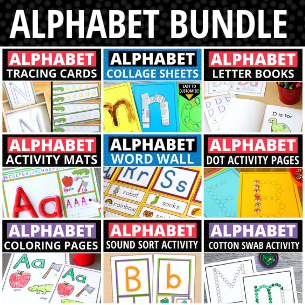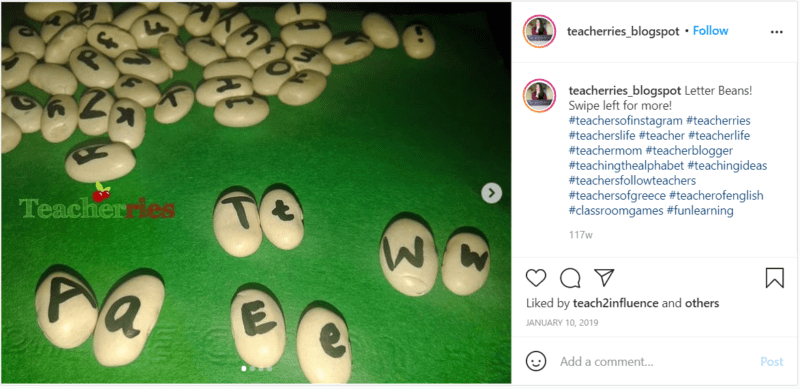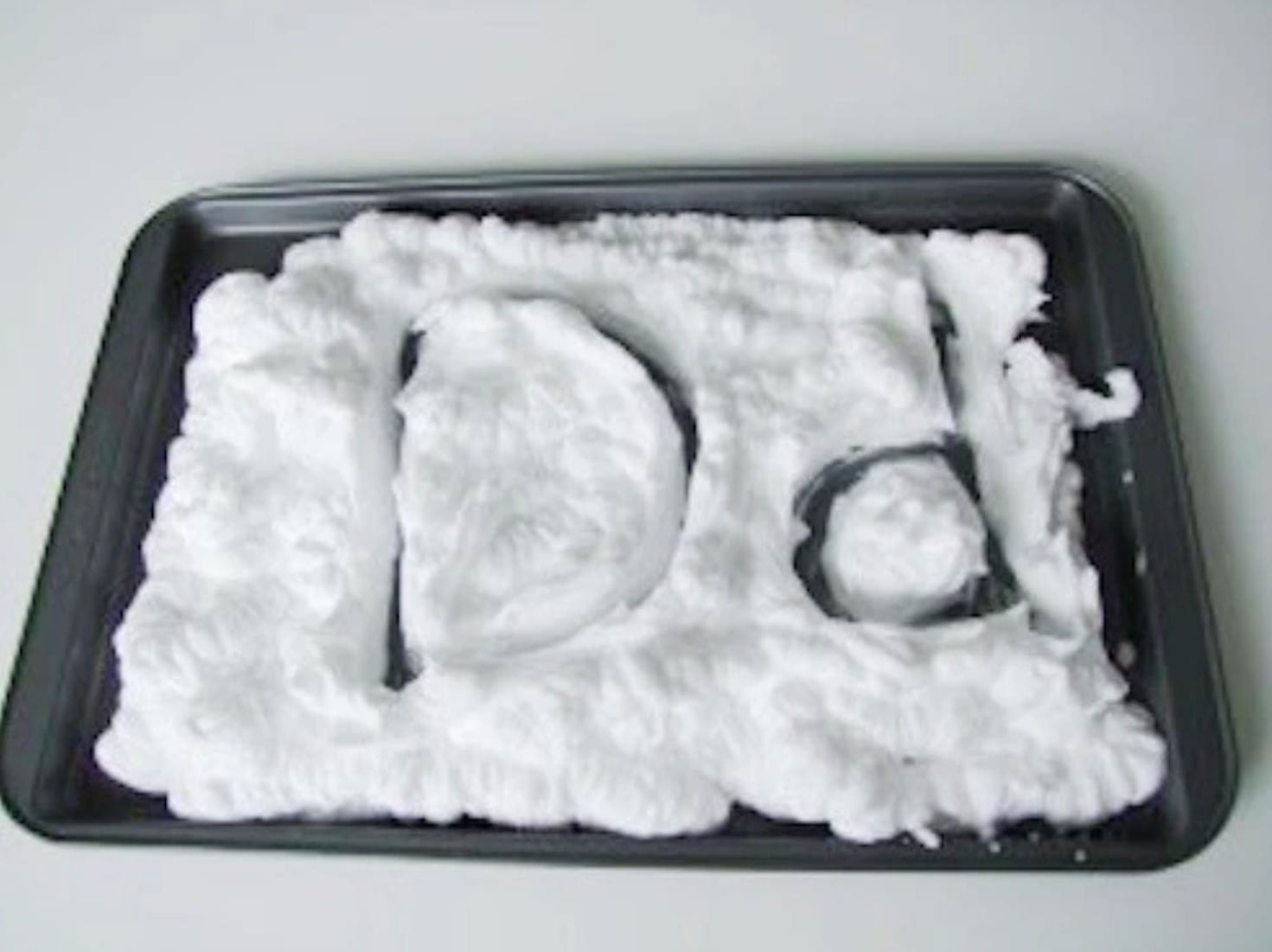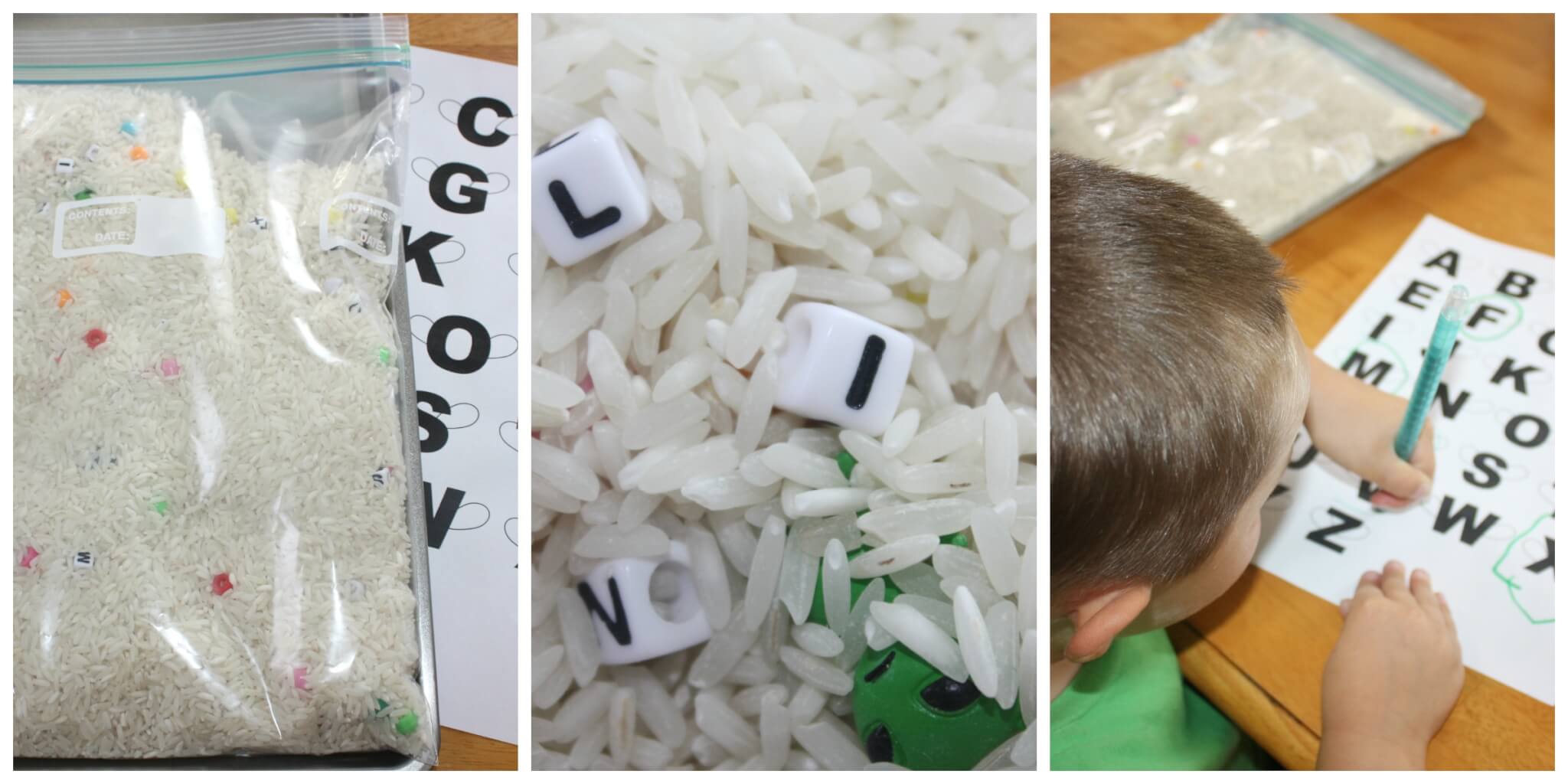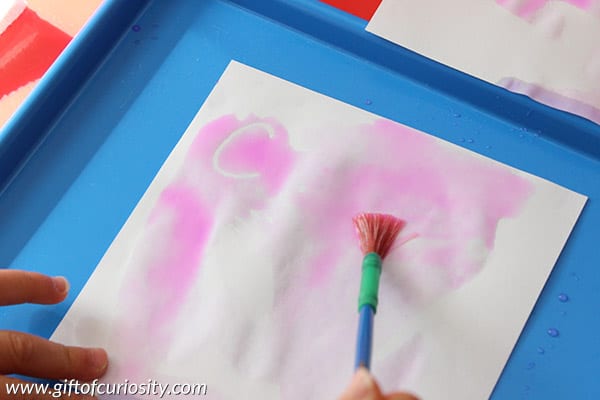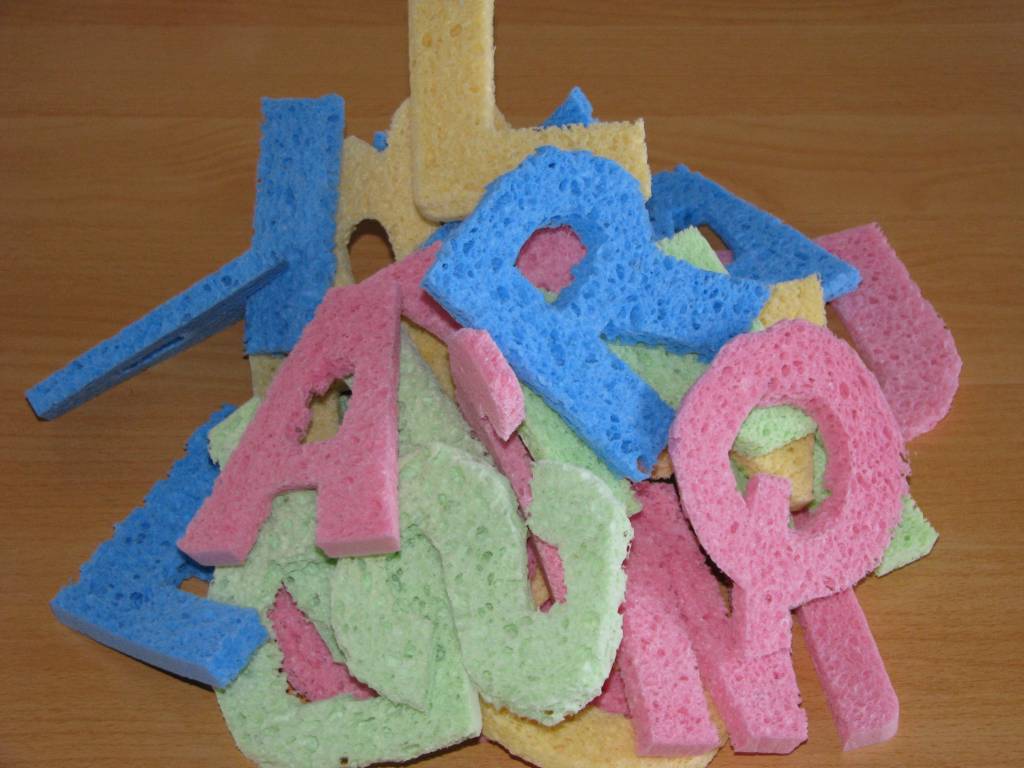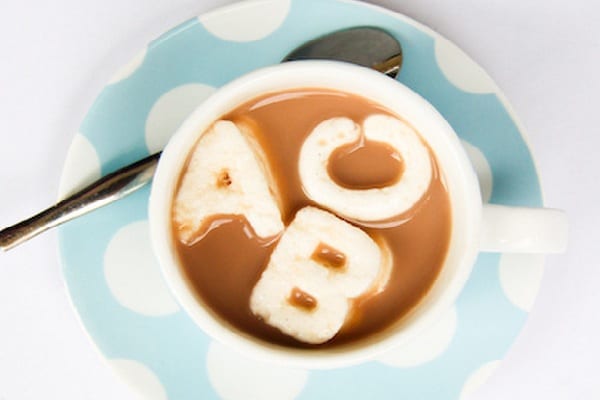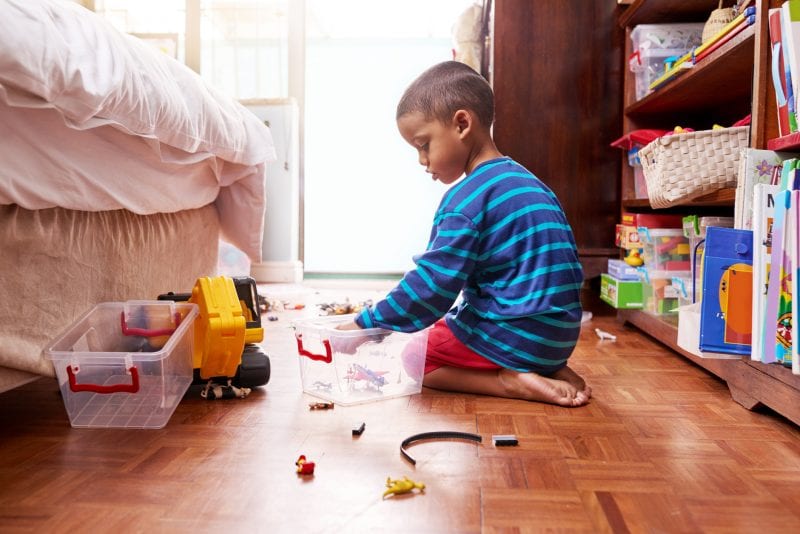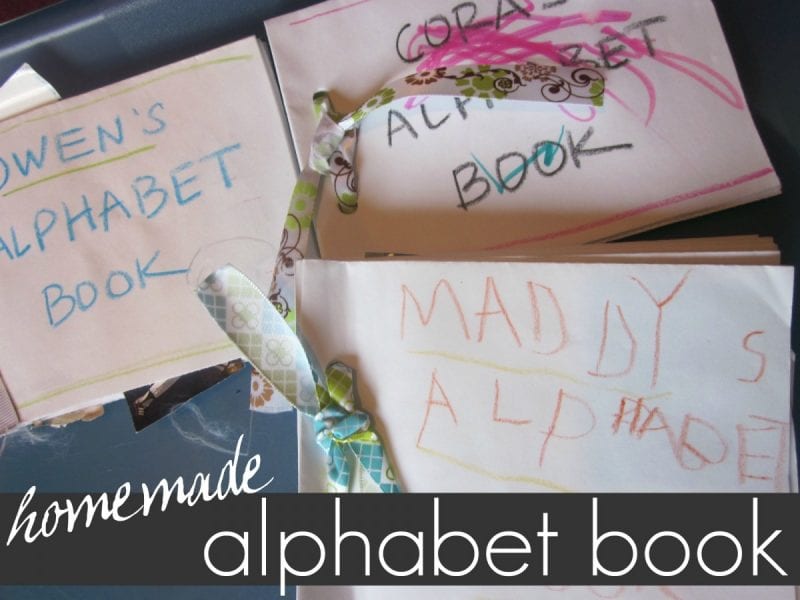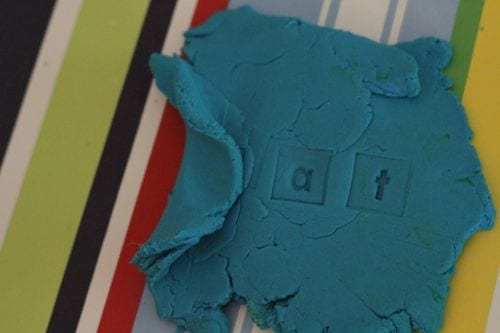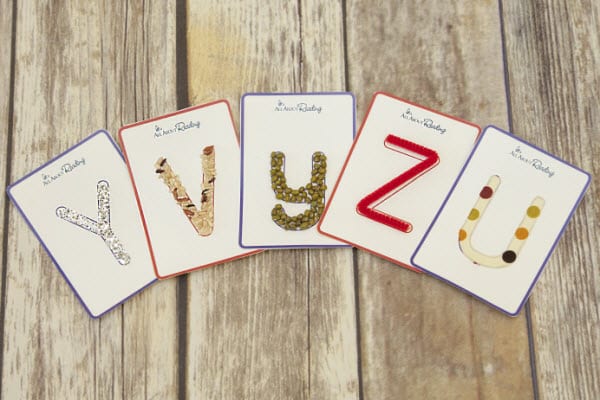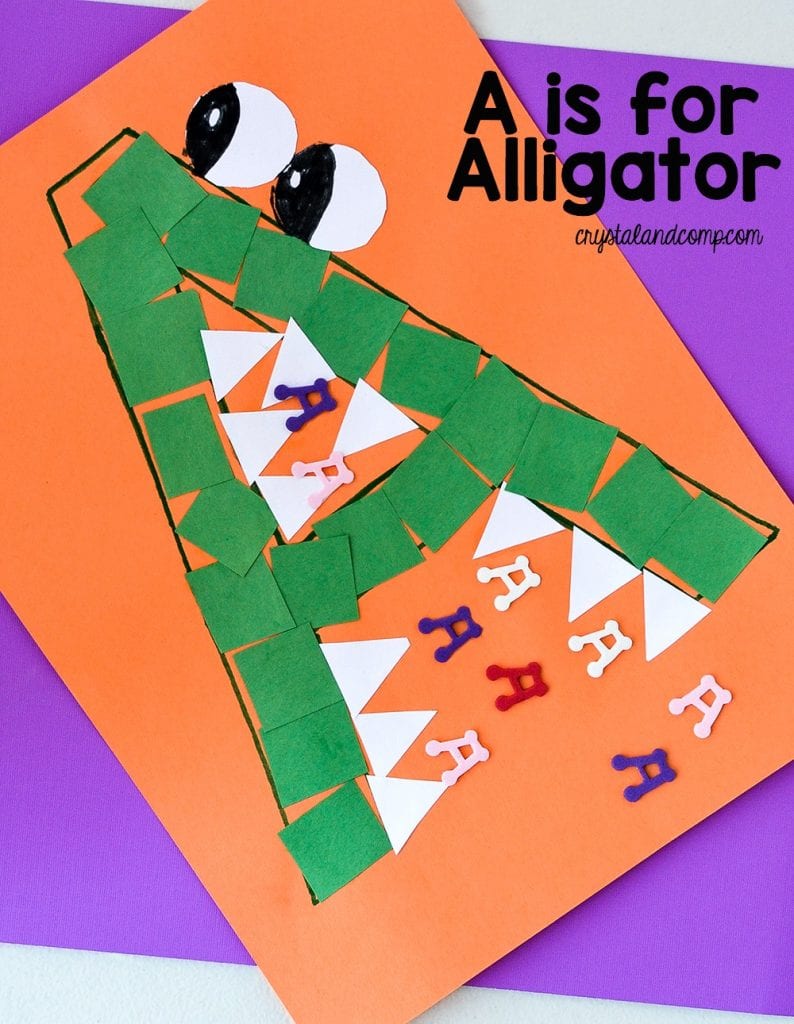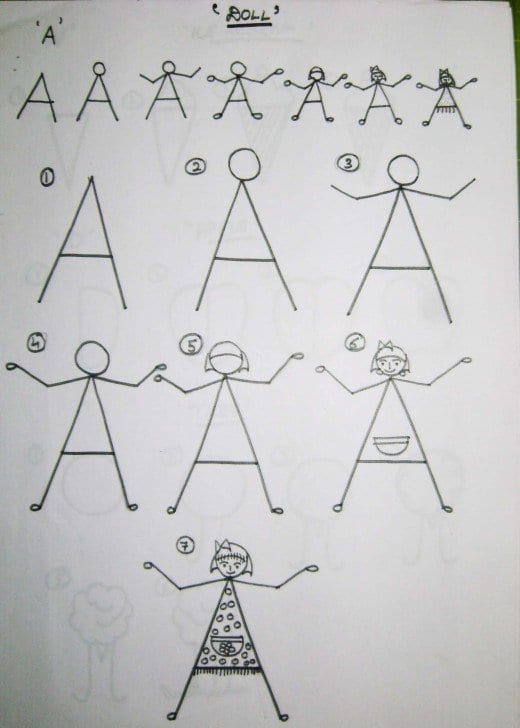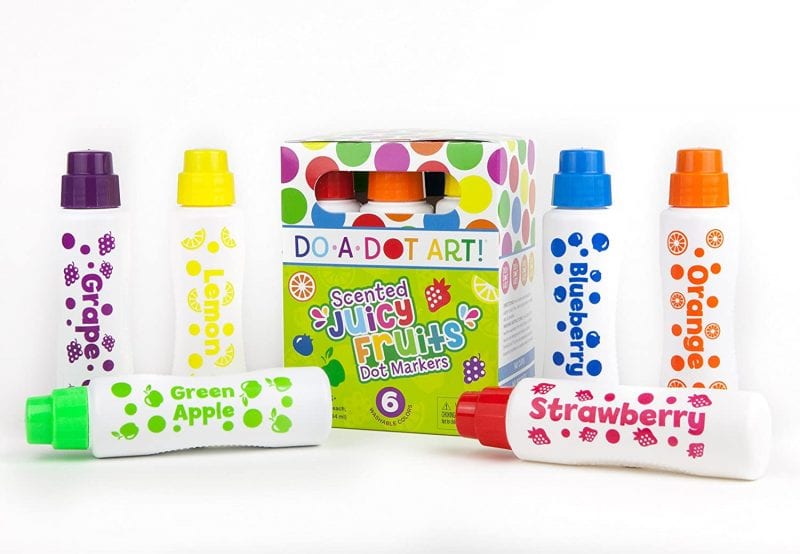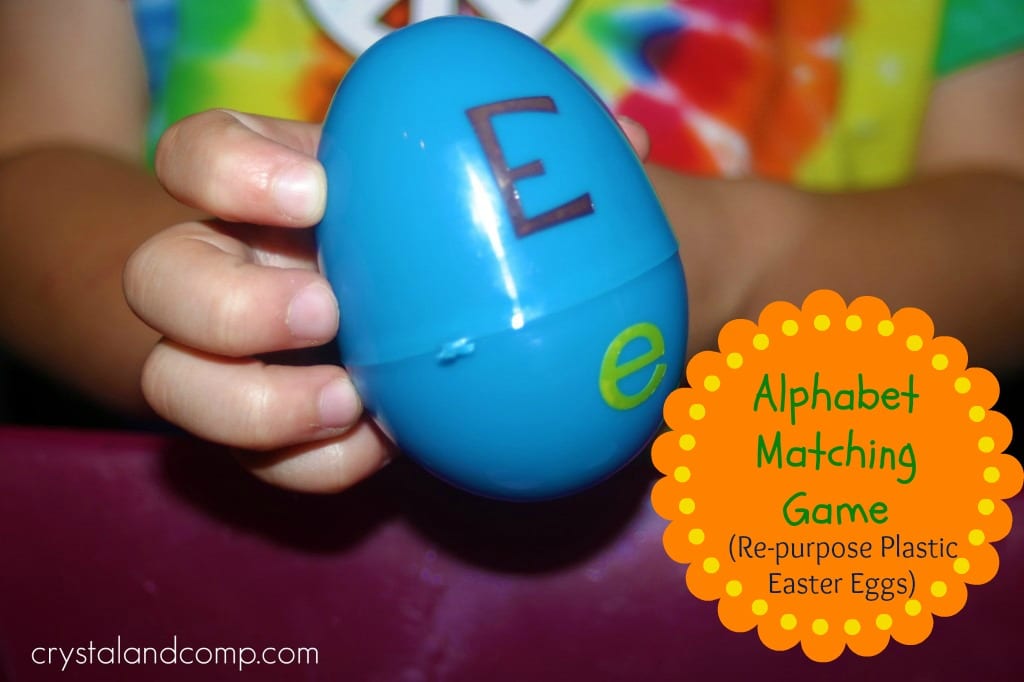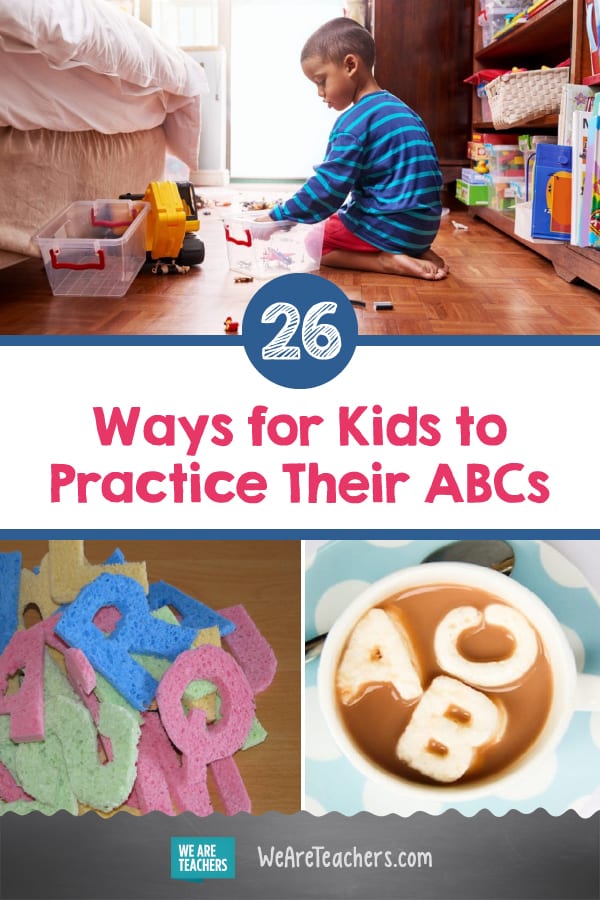According to traditional grammar, a word is defined as, “the basic unit of language”. The word is usually a speech sound or mixture of sounds which is represented in speaking and writing.
Few examples of words are fan, cat, building, scooter, kite, gun, jug, pen, dog, chair, tree, football, sky, etc.
You can also define it as, “a letter or group/set of letters which has some meaning”. So, therefore the words are classified according to their meaning and action.
It works as a symbol to represent/refer to something/someone in the language.
The group of words makes a sentence. These sentences contain different types of functions (of the words) in it.
The structure (formation) of words can be studied with Morphology which is usually a branch (part) of linguistics.
The meaning of words can be studied with Lexical semantics which is also a branch (part) of linguistics.
Also Read: What is a Sentence in English Grammar? | Best Guide for 2021
The word can be used in many ways. Few of them are mentioned below.
- Noun (rabbit, ring, pencil, US, etc)
- Pronoun (he, she, it, we, they, etc)
- Adjective (big, small, fast, slow, etc)
- Verb (jumping, singing, dancing, etc)
- Adverb (slowly, fastly, smoothly, etc)
- Preposition (in, on, into, for, under, etc)
- Conjunction (and, or, but, etc)
- Subject (in the sentences)
- Verb and many more!
Now, let us understand the basic rules of the words.
Rules/Conditions for word
There are some set of rules (criteria) in the English Language which describes the basic necessity of becoming a proper word.
Rule 1: Every word should have some potential pause in between the speech and space should be given in between while writing.
For example, consider the two words like “football” and “match” which are two different words. So, if you want to use them in a sentence, you need to give a pause in between the words for pronouncing.
It cannot be like “Iwanttowatchafootballmatch” which is very difficult to read (without spaces).
But, if you give pause between the words while reading like, “I”, “want”, “to”, “watch”, “a”, “football”, “match”.
Example Sentence: I want to watch a football match.
We can observe that the above sentence can be read more conveniently and it is the only correct way to read, speak and write.
- Incorrect: Iwanttowatchafootballmatch.
- Correct: I want to watch a football match.
So, always remember that pauses and spaces should be there in between the words.
Rule 2: Every word in English grammar must contain at least one root word.
The root word is a basic word which has meaning in it. But if we further break down the words, then it can’t be a word anymore and it also doesn’t have any meaning in it.
So, let us consider the above example which is “football”. If we break this word further, (such as “foot” + “ball”), we can observe that it has some meaning (even after breaking down).
Now if we further break down the above two words (“foot” + “ball”) like “fo” + “ot” and “ba” + “ll”, then we can observe that the words which are divided have no meaning to it.
So, always you need to remember that the word should have atleast one root word.
Rule 3: Every word you want to use should have some meaning.
Yes, you heard it right!
We know that there are many words in the English Language. If you have any doubt or don’t know the meaning of it, then you can check in the dictionary.
But there are also words which are not defined in the English Language. Many words don’t have any meaning.
So, you need to use only the words which have some meaning in it.
For example, consider the words “Nuculer” and “lakkanah” are not defined in English Language and doesn’t have any meaning.
Always remember that not every word in the language have some meaning to it.
Also Read: 12 Rules of Grammar | (Grammar Basic Rules with examples)
More examples of Word
| Words List | Words List |
| apple | ice |
| aeroplane | jam |
| bat | king |
| biscuit | life |
| cap | mango |
| doll | nest |
| eagle | orange |
| fish | pride |
| grapes | raincoat |
| happy | sad |
Quiz Time! (Test your knowledge here)
#1. A word can be ____________.
all of the above
all of the above
a noun
a noun
an adjective
an adjective
a verb
a verb
Answer: A word can be a noun, verb, adjective, preposition, etc.
#2. A root word is a word that _____________.
none
none
can be divided further
can be divided further
cannot be divided further
cannot be divided further
both
both
Answer: A root word is a word that cannot be divided further.
#3. A group of words can make a ___________.
none
none
sentence
sentence
letters
letters
words
words
Answer: A group of words can make a sentence.
#4. Morphology is a branch of ___________.
none
none
Linguistics
Linguistics
Phonology
Phonology
Semantics
Semantics
Answer: Morphology is a branch of Linguistics.
#5. The meaning of words can be studied with ___________.
none
none
both
both
Morphology
Morphology
Lexical semantics
Lexical semantics
Answer: The meaning of the words can be studied with Lexical semantics.
#6. The word is the largest unit in the language. Is it true or false?
#7. Is cat a word? State true or false.
Answer: “Cat” is a word.
#8. A word is a _____________.
group of paragraphs
group of paragraphs
group of letters
group of letters
group of sentences
group of sentences
All of the above
All of the above
Answer: A word is a group of letters which delivers a message or an idea.
#9. A word is usually a speech sound or mixture of it. Is it true or false?
#10. The structure of words can be studied with ___________.
Morphology
Morphology
both
both
Lexical semantics
Lexical semantics
none
none
Answer: The structure of words can be studied with Morphology.
Results
—
Hurray….. You have passed this test! 🙂
Congratulations on completing the quiz. We are happy that you have understood this topic very well.
If you want to try again, you can start this quiz by refreshing this page.
Otherwise, you can visit the next topic 🙂
Oh, sorry about that. You didn’t pass this test! 🙁
Please read the topic carefully and try again.
Summary: (What is a word?)
- Generally, the word is the basic and smallest unit in the language.
- It is categorised based on its meaning.
- Morphology is the study of Words structure (formation) and Lexical semantics is the study of meanings of the words. These both belong to a branch of Linguistics.
- A word should have at least one root and meaning to it.
Also Read: What is Grammar? | (Grammar definition, types & examples) | Best Guide 2021
If you are interested to learn more, then you can refer wikipedia from here.
I hope that you understood the topic “What is a word?”. If you still have any doubts, then comment down below and we will respond as soon as possible. Thank You.
Alphabet activities make learning your ABCs more fun. There are so many ways to practice your ABCs, you might be able to do one alphabet activity a day for a year without repeating. We’ve gathered over 25 super fun alphabet activities so kids can play and learn every day.
1. Write letters on dried beans
Large dried white beans are inexpensive to purchase and easy to write on. Grab a sharpie and write all the upper and lower case letters on them. Then put each set in a pile (or baggie) and ask your kids to match them.
2. Letter sort with sticky notes
Write individual letters on sticky notes and then place them all over your house or just on every stair in a staircase. This practice game has a lot of variations—all tied to sorting. Ask kids to sort by:
- lowercase
- uppercase
- letters in their name
- straight lines (H)
- curved lines (c)
- both curved and straight lines (B)
- consonants
- vowels
For even more practice: have them sort their finds into ABC order, match lowercase letters to uppercase letters, and then, find a way to sort them that’s new.
3. Write letters in shaving cream
Squirt shaving cream on a table and let your kids write letters in the cream. Smoothe it out to erase and start again. Bonus: their hands and your table will be cleaner than ever!
Source: Rose and Rex
4. Bend letters with pipe cleaners
Pipe cleaners have always been a trusted source of good fine motor practice as well as a fun craft resource. Now use them to have kids create uppercase and lower case letters.
Learn more: make and takes
5. Make sensory ABC bags
This one is great because you can change up what you put in here and even move to sight words. You’ll need a gallon bag with a ziplock top. Add letters written on pieces of paper, magnetic letters, scrabble tiles, or anything else you can think of with letters. Then fill the bag with rice or oatmeal and seal it. Kids dig through the rice through the bag to find the letters. When they find them, they write down the letter they find until they locate all 26 letters of the alphabet.
For more sensory ideas: Little Bins Little Hands
6. Find invisible letters with watercolors
This is a classic. Using a white crayon, draw letters on a piece of white paper. Give your kids watercolor, let them paint the paper, and watch the letters appear.
Learn more: Gift of Curiosity
7. Play musical alphabet
Set up letters in a big circle on the floor. You can use magnetic letters or just write them on index cards. Put music on and have your child walk around the circle to the music. When the music goes off, your child tells you the closest letter. Expand on it: ask your child to name three things (colors, animals, etc) that start with that letter.
8. Sponge the alphabet
Cut sponges into letters and use them for sponge painting letters or playing in the tub.
Learn more: Learning 4 Kids
9. Put together name puzzles
Write the upper and lower case letters in a name and then cut them apart in a simple zigzag. Mix up the letters and ask a child to match them up and put them in the right order.
10. Make letters from nature
Find the alphabet right outside. Choose natural objects that already look like letters, or arrange them to look like them.
To learn more: Right Brained Mom
11. Eat your ABCs
We know from Alphabet Soup that eating your ABCs is plain old fun. So think of all the ways you can practice the alphabet at mealtime. Pancakes can be made into letters, jello can be cut into letters, and noodles can be used to make letters (just to name a few).
Learn more: Parent Map
12. Go on an alphabet scavenger hunt
The fun part about this for grown-ups is that there is no prep. Tell kids to go find objects that start with each letter of the alphabet. To make this game take longer, designate spots for them to bring each item back—one at a time. Every item must be approved before they can move on to the next. This allows for fewer meltdowns at the end when an item is deemed inaccurate.
13. Make your own ABC book
Personalizing the ABCs helps kids process and retain their learning. One of our favorite alphabet activities starts by creating a book out of 26 pieces of paper and staples or hole punches and a ribbon. Have kids write an uppercase and lowercase letter on each page. Finally, have them draw or cut out pictures of things that start with each letter. Voila!
Learn more: Teach Mama
14. Create ABC popup books
Use the following tutorial video to learn how to make different kinds of pop up pages. Then, create a page per week for 26 weeks for each letter. At the end, use a glue stick to glue them all together to make an ABC popup book!
15. Stamp letters in playdough
Roll out playdough and push letter stamps right into the dough. This is both tactile and great for practicing ABCs.
Learn more: I can teach my child
16. Make tactile letter cards
There’s lots of research (and experience) to support the value of using all the senses to learn. Making these tactile alphabet cards will be fun and have lasting benefits.
Learn more: All About Learning
17. Trace letters in spices
This one combines touch, smell, and sight. It gives you an opportunity to talk about what we uses spices for as well. Put the bottle in front of a child and have them write the spice name in the spice to make things a bit more challenging.
Source: Frog in a Pocket
18. Study a letter of the week
Many PreK and Kindergarten classes do a letter of the week, and for good reason. Teachers all share that instant recognition of letters and practice writing them is so important for learning to read. Doing alphabet activities for one letter each week reinforces knowledge and recollection.
For weekly activities: Preschool Mom
19. Do the yoga alphabet
Show kids this video and take the time to learn each yoga pose. Connecting the mind and the body is great for learning.
20. Sing songs about the alphabet
Everyone loves to sing the alphabet song, but did you know there are lots of other songs to sing that can help you remember the alphabet? Try out this Sesame Street favorite:
21. Draw pictures from letters
Using letters as a starting point, teach kids how to draw. If this is too difficult at first, just write a letter and then draw a picture around the letter.
Learn more: Felt Magnet
22. Highlight letters on a page
Print a page of text or grab your favorite magazine and a highlighter. Ask kids to highlight as many of one letter as they can find. This is also great for sight word recognition.
Here’s a freebie from The Inspired Apple to get you started.
23. Do-A-Dot letter tracing
These dot markers make tracing letters more fun and help kids with directionality and remembering how to write and recognize letters.
Free Dot tracing sheets: DTLK’s Educational Activities for Kids
24. Play letter slap
Make 2 sets of index cards with all the letters on them (52 cards in all). Shuffle the cards together and deal them so each kid holds 26 cards. Together each player takes their top card and turns it upright. The player with the letter closest to A wins the hand and takes the card. If two of the same letter are played, the players slap the card. The one on the bottom of the slip wins the hand. The game ends when one player holds all the cards.
25. Match plastic Easter egg letters
Surely you have some plastic Easter eggs hanging around your attic. Use a Sharpie or letter stickers to put an uppercase letter on one half and a lowercase letter on the other. Then separate the two and throw them all in a basket. Kids pull them out and match them up. Tip: Add difficulty by not coordinating the colors.
Learn more: Crystal and Co.
26. Create loose part letters
What are loose parts? Loose parts are exactly what they sound like—a collection of loose materials or objects. These can be small pebbles, bottle caps, random LEGO bricks, seeds, keys, anything. Draw big letters on a piece of paper and have kids line up loose parts to make the letter.
Recognizing letters is a fundamental part of learning how to read. Without it, children struggle to learn letter sounds and identify words. Beginning readers who know their alphabet have a much easier time learning to read. Making alphabet practice a part of every day in fun ways helps create a lifelong love for letters and words.
What games and activities do you like to use for practicing the alphabet?
Plus, our favorite activities using alphabet beads and the best alphabet books.
The acquisition of new vocabulary is essential in terms of overall language advancement. However, there is always a need to review active words from time to time in order to use them fluently in speech. Here, we will present a couple of great vocabulary revision games which will perk up every classroom. Through these games the learners will feel how fun, entertaining and effective the learning process can be.
1. Charades
Charades is a fun and cool revision game. Students need to practice their acting skills to explain the words. This game is extremely easy to organize with minimal advance preparation. The only thing to be ready for is to keep a collection of vocabulary cards for the words you have studied.
The class is divided into two teams. Each team member takes turns acting out one of the words from the vocabulary set and explains it by acting out the word. If his or her own team can’t guess the word, the opposite team gets the chance to guess it. Each right answer equals one point.
Skyeng ищет преподавателей английского. Подробности по ссылке: Skyeng
2. Pictionary
Pictionary is also an entertaining game to play for vocabulary review. The rules are similar to those of charades except that instead of acting out the word, it is drawn on the board.
3. Bingo
Bingo can serve as a good revision game. From my experience, most of the groups/students like playing bingo because it gives them the chance to reflect on the words they have digested.
Students are given a blank bingo board and are asked to put the review words into the squares randomly. The teacher puts the active words in a hat or a box, takes them out one by one and defines them. If the student has a word corresponding to the definition, he crosses it out on his bingo board. When someone gets five squares in a row, they should shout, “Bingo!”
Check these articles out as well:
4. A memory style
A memory style card game can be another effective way for reviewing vocabulary. It requires some preparation before the game starts. For each word to be reviewed, one card should have the target vocabulary word and another card should have the definition of the word. You also need to have a big playing grid where you put the words and their definitions face down.
Each person turns over two cards each turn trying to find a match. If the cards do not match, he turns them over again and the next person tries to find a match. If he succeeds, he keeps the cards and gets an additional turn. The player with the highest number of cards at the end of the game wins.
The game can be modified even further. If you have accumulated enough synonyms or antonyms to the target vocabulary, you can practice matching target words to their antonyms or synonyms.
5. Categories
Categories is another awesome revision game which will make students energized and empowered. What they need for the game is to draw 4-6 columns on their paper and write a category at the top of each column. Categories fit the topics covered during the course. For example, if you have covered the business topics of Marketing, Work and Leisure, Ethics, Human Resources, Travel, you write these topics as categories.
You time the students and ask them to write as many words as possible under each category. As a further modification, choose a random letter and write it on the board. Give students enough time to write down a word for each category that starts with that letter.
Экономьте время на подготовку к урокам и проверку домашних заданий со Skyeng. Удаленный формат занятий, защита от внезапных отмен и график, который настроен специально под вас. Присоединяйтесь к нашей команде. Подробности по ссылке: Skyeng
6. Letter scramble
Letter scramble will make students really competitive and super fast. What you need is to take a list of words that your students have recently learned and write a scrambled version of each on the board. Students need to unscramble the words on their paper. The first one to finish deciphering all the words wins.
7. Stop the bus
Stop the bus is a cool game my students adore. I usually divide the class into 2-3 teams. One student from each team. This student sits on a chair facing his peers. Then from behind the student in the hot seat, show the other students a word from the lesson. The other students must try to describe what the word is without saying the actual word. And the student in the hot seat must guess.
The student who guesses the word shouts out “stop the bus” and checks the word with the teacher. If correct, the team gets a point. If wrong, other teams have the chance to guess the word by writing their versions on a piece of paper and passing the papers to the teacher.
8. Puzzles
Puzzles is another cool and easy tool to review the material in an effective way. What I like about this way of vocabulary revision is that students can work in pairs or groups while trying to find words matching the definition in the crosswords. They learn by listening to each other, cooperating to find the right answer. In this way, they both review the material and improve their teamwork skills.
Follow this link to get templates of different types of puzzles.
We also recommend watching a video with Alexei Konobeev. The speaker shared games to help your students remember new vocabulary. These games do not require special training and you can adapt them to any age and level.
We hope that all these games would serve their best to liven your vocabulary revision sessions and make them more meaningful and effective.
Which of these games have you tried? Which ones have you picked up for your next revision slot?
What is Letter? Letter Definition, Types of Letter, Definition of Letter – A letter is a written message sent by one person to another. In other words, a letter is a piece of conversation by post. So, when we transfer any written message through mail, it can be termed as letter.
According to Oxford Dictionary, “A letter is a message that is written down or printed on paper and usually put in an envelope and sent to somebody.”
From the above discussion, it can be said that a letter is a written message, printed or hand written, that is sent to someone by other through post or mail or in some other way.
Types of Letter
Letter is an important symbol of human civilization. It has been used as a media of exchanging information from the primitive age. Letter can be categorized into different types based on formalities maintained, information contained, purpose of use etc. A comprehensive classification of letter is shown below- 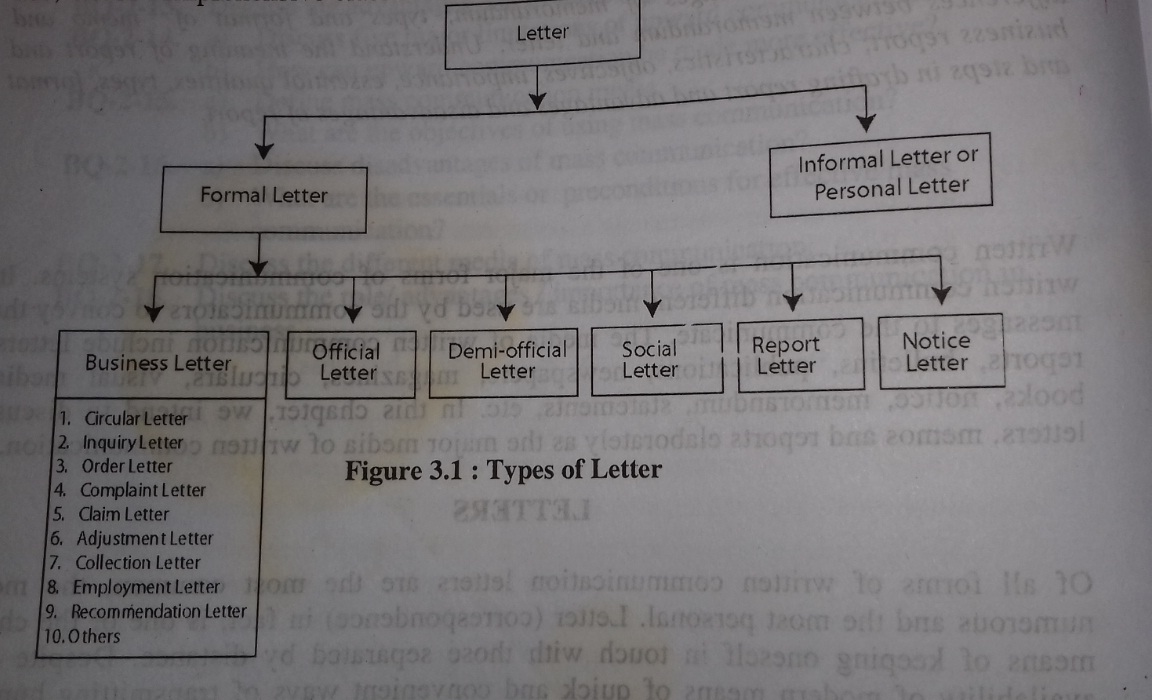
- Formal Letter: The letter which is written according to the formal rules and regulations of an organization is called formal letter. This type of letter always maintains the formalities of the office strictly. Institutional and business letter fall in this category.
- Informal or Personal Letter: The letter which does not follow any formal rule and contains personal information is known as informal or personal letter. This type of letter is written to relatives and friends for exchanging news or feelings or to seek favors. The basis of writing personal letter is personal relationship.
- Business Letter: The letter which contains commercial information and is written among business people is called business letter or commercial letter. Business letters are formal, structured and non-personal. Commercial letter contains information relating to trade inquiry, circular, order, complaint, claims, adjustment, collection relating to trade inquiry, circular, order, complaint, claims, adjustment, collection etc.
- Official Letter: When letter is written containing the official information like rules, regulations, facts and figures, activities, system, procedure etc. it is called official letter. In other word, when a letter is written following the official decorum, it is known as official letter. Officials use this type of letter to send official message to other branches and offices. Official letter strictly follows the prescribed rules, regulations, structure and style of the office.
- Social Letter: Letter that is written on any social occasion or purpose is called social letter. Invitation letters for different programs, thanks letter, condolence letter, congratulation letter etc. fall in the category of social letter. It is actually one kind of personal letter.
- Report Letter: Letter that is prepared in the form of report or investigation and is sent to the person, who has assigned it, is called report letter. In real sense, it is a short report in the form of letter. The letter sent to the sales manager by the sales man on every day’s sales volume in an example of report letter.
- Notice Letter: Notice letter is a letter that is sent to a person notifying or informing him about any special topic.
- Circular Letter: A letter that circulates or announces the same information or message to a large number of people at a time is called a circular letter or a circular. Announce of new product, change of business address, retirement or admission of partner etc. requires circulating the certain message. For this purpose circular letter is written.
- Order Letter: When the quotation of the seller satisfies the queries of the prospective buyer, he places order through an order letter. So, after granting the quotation, the letter which the buyer writes to the supplier or seller, requesting him to deliver the prescribed amount of goods is called an order letter.
- Complaint Letter: However efficient an organization may be in running a business, everything does not go all the time according to plan. There will be some mistakes and some accidents. Letters written to bring these mistakes to the notice of those who must own the responsibility for them are called claim or complaint letters.
- Employment Letter: Letters which are written in case of employment are considered as employment letter. Job application letter, appointment letter, joining letter, promotion letter etc are examples of employment letters.
Beyond the above mentioned categories there are some other letters also such as bank letter, public letter, level letter, increment letter, permission letter etc.
Add variety to your alphabet instruction with these 9 fun alphabet activities for preschoolers. You can even download a sampler of letter A printables to try them out today.
Are you looking for some fun ways to teach the alphabet to your kids?
During the summer I avoided the steamy 100+ temperature by sitting inside reading No More Teaching a Letter a Week by Rebecca McKay and William H. Teale. Under the cool vent of the AC, I was struck by how many times the authors mentioned that kids benefit from varied and repeated exposure and practice with the alphabet.
I know that I like a little variety when I learn. How about you?

There is no need for you to search all over Pinterest for a bunch of activities that will interest your kids as they learn the alphabet.
Today, I’m excited to tell you about the 9 different letter activities that are included in my Super Alphabet Bundle. The wide variety of activities are great for in the classroom or for parents to do at home.
They will give you the opportunity to work on alphabet knowledge in many different ways with your kids.
Plus, you can even sample the printable activities.
How to teach the alphabet
Learning the alphabet involves much more than reciting the ABC song. Kids learn the alphabet when they
- learn letter recognition
- learn letter sounds
- learn to form letters
Kids can learn the alphabet through name activities, by reading books, through playful multi-sensory alphabet activities.
There are MANY ways to help kids learn letters, and it’s best to provide a variety of activities.
Let me show you 9 printables to help kids learn the alphabet.
The first activity that I want to share is alphabet dot pages. These printable alphabet dot letters can be used to work on letter recognition, letter formation, and letter-sound knowledge.
Kids can trace the letters with their fingers to learn to recognize the unique features of each individual letter. I love that this activity can also be a great fine motor exercise. Kids enjoy placing stickers, loose parts, or sticky fingerprints in each circle of the letters.
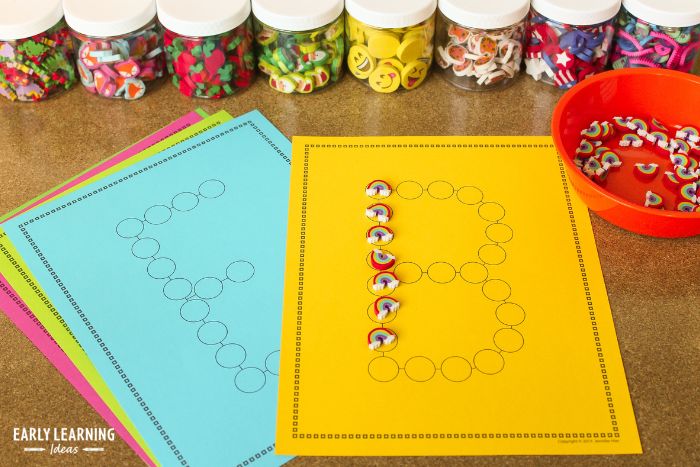
To get tons of ideas for using the pages, check out this article about alphabet dot letters
2. An Alphabet Word Wall
Next, you can create a print-rich environment in your classroom with word wall cards. The alphabet header cards in this word wall set are large, square cards with a simple border and large letters so that kids can focus on what is important…the letters. Each word card contains a word in a large, clear, simple font along with a simple illustration…..again clear and simple.

You can also create name cards or custom cards for your word wall. Kids love seeing some environmental print cards up there too.
Because of the trademarked logos, I can’t add environmental print cards to the printable set.
But….let me share a secret…..
You can make them by using a logo image in place of a child’s photograph. Have fun creating them. Teachers proudly displayed the Ohio State logo on our word walls when we lived in Columbus, Ohio.
In addition to using the set as a word wall, you can use the resource in pocket charts, on word rings in your writing center. You can also use the word cards and alphabet header cards as a sorting activity, for a word scavenger hunt, or as a matching game
3. Start with a Dot – Letter Formation Activities
Giving kids the opportunity to produce letters will help them learn to recognize the letters. This alphabet tracing activity set includes several different cards to help kids learn to produce letters.
Letter Tracing Cards in a Salt Tray
Finger tracing cards provide a great way to help children learn the differences among the letters. A starting dot serves as a visual reminder on where to start letter formation.
Kids can finger trace directly on the cards or can use the cards as a reference as they reproduce the letters in a salt tray, on a blank wall, or in the air with their magic finger.
Do you want to know how to put together a salt tray? Check out this salt tray post for some great ideas to make an exciting salt tray for your kids.
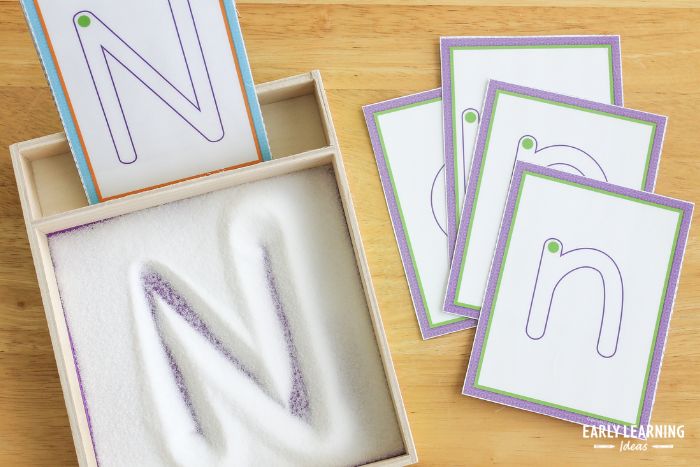
Create Tactile Letter Cards
You can also use the cards to make tactile letter cards. Kids love feeling the letters and don’t even realize that they are learning as they do it. Find direction and LOTS of ideas in my article about tactile letters.
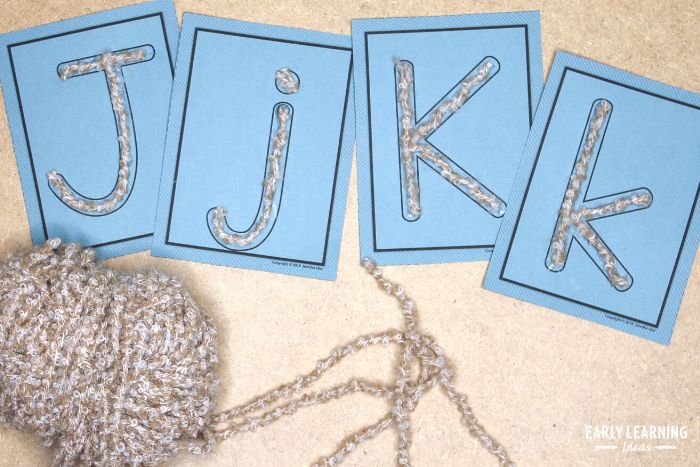
Alphabet Tracing Strips
The set also includes 3 sets of alphabet tracing strips so that kids can also practice letter formation with a real-life writing instrument (not a magic finger).
Each set of tracing strips have a different style of tracing font
- yellow
- dotted
- outlined
Some children may find it easier to see their writing on top of the yellow letters, some children may enjoy the challenge of trying to keep their writing within the lines of the outlined letters. Use the style of tracing stripes that are best for your kids.
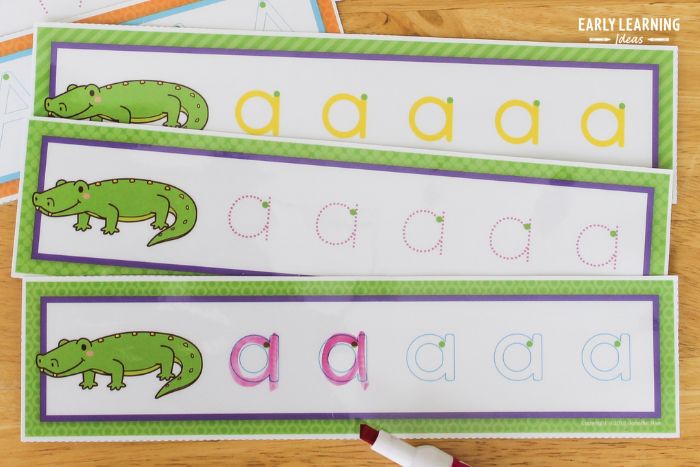
These are not like old-school letter tracing activities. You know what I mean…the ones with all the arrows and numbers. I do not like those things!
Don’t Distract Me! – Arrows and numbers on tracing letters easily distract me. I prefer to use a simple green starting dot on my tracing activities. The dot provides a visual clue to help kids know where to begin when forming letters.
4. My Favorite – Editable Alphabet Activity Sheets
These editable pages provide endless letter activities for your kids.
Practice letter recognition and phonemic awareness in creative and multi-sensory ways. The full set contains lowercase and uppercase editable letter pages, uppercase and lowercase pages without text, 1 full-color editable cover page, and 1 black and white editable cover page.

These letter sheets are my favorite alphabet activity because there are so many ways to use them.
- Create an alphabet book by binding a cover together with ABC pages.
- Make a tactile alphabet book and let kids finger trace the letters.
- Make alphabet pages featuring your kids’ names.
- Create a class name book.
- Use the sheets, along with small manipulative or toys, as play mats or play dough mats.
- Create letter activities or art/craft projects with the letter sheets.
- Use the sheets without text as coloring pages or take-home pages.
If you want to use materials that coordinate with each letter of the alphabet, check out this article for a HUGE list of material ideas for your letter activities.
5. The All-in-One ABC Play Dough & Activity Mats
If you are looking for an easy printable that provides multi-sensory opportunities to practice letter recognition, letter formation, and letter-sound association …all on one page…this alphabet activity mat is it. The full set contains 26 full-color alphabet mats and 26 black and white alphabet mats.
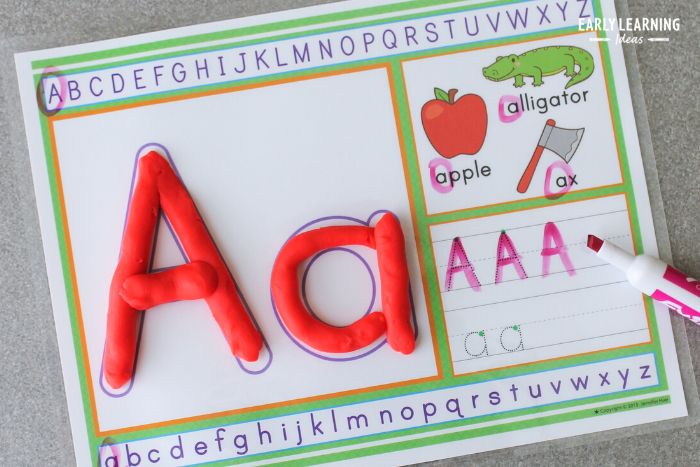
Each alphabet mat contains five sections.
- Alphabet Square – Children can finger trace the large letters or they can place a coil of play dough, wikki stix, or small objects on top of the letter. They can also color the letters.
- Uppercase Alphabet Line– Encourage kids to search for and circle the focus letter among the other letters in the alphabet.
- Beginning Sound Examples– Review the objects pictured with your kids. Name the objects and listen for the beginning sound. Practice the sound associated with the letter. Kids can also search for the letter in each word, and/or circle the letter in each word. Kids can color the pictures on the black and white version.
- Letter Formation Practice– Here is an opportunity to trace letters and write letters on the lines.
- Lowercase Alphabet Line- Finally, kids can search for and circle the focus letter among the other lowercase letters in the alphabet.
6. Alphabet Letter Books That Assemble in a Snap
My little alphabet letter books are simple, uncluttered, and are a great way to help kids understand print. The simple, predictable text and pictures are easy for kids to read aloud. Your kids will have the opportunity to practice letter recognition and phonological awareness.
Print the full-page book and use it in the class library and print off the little books for a literacy activity that you can send home with your kids.
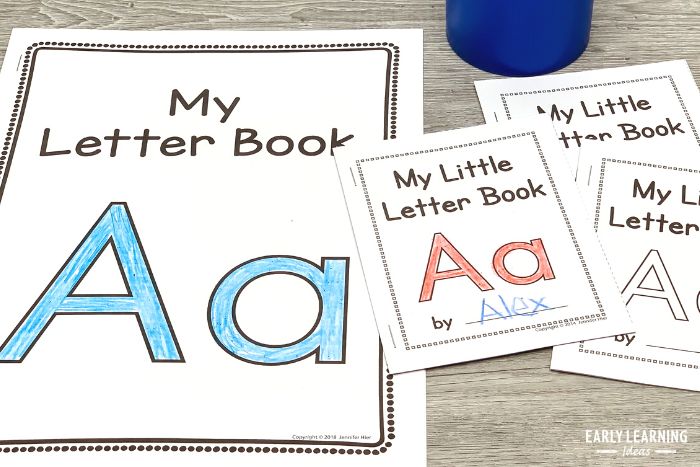
Each little book contains a cover, 2-3 picture pages, and a letter tracing page.
- Kids can finger trace, color or use rainbow writing on the large letters on the cover of each book.
- There is simple predictable text on each picture page.
- Kids can read the sentence on the picture pages, circle the letter within the sentence, and color the pictures.
- The letter formation page provides young children an opportunity to trace and write both capital and lowercase letters. A simple starting dot is a great way to help kids learn letter formation without other distractions.
Busy teachers appreciate that the little books are easy to assemble. Check out this video to see how easy it is to assemble four books in a snap.
Because so many people started teaching preschool at home during the pandemic, I updated the to include an option where you won’t end up with 4 copies of the same book.
7. Learning Letters with Fine Motor Activities
Get out the q-tips and learn letters and work on fine motor control with these fun cards. Your kids will learn to recognize letters and proper letter formation (note that the starting point is highlighted) with this fun activity. Check out this article about learning letters with fine motor activities to get more activity ideas.
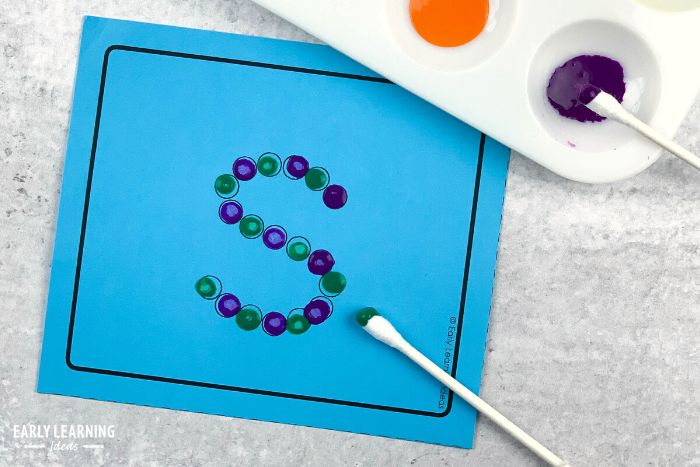
8. Sorting Words by Beginning Letter and Sound
This ABC picture sort activity gives children the opportunity to practice phonemic awareness skills. The beginning sound sorting activity includes a complete set of uppercase and lowercase letter boards as well as 52 picture cards (2 for each letter of the alphabet).
You can assemble the cards so that they have the name of the pictured object written on the backside.
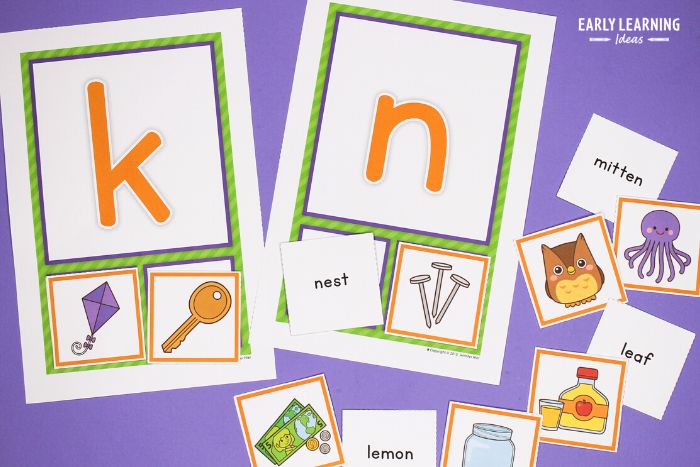
Ideas for sorting activities and small group games are included.
9. Alphabet Coloring & Activity Pages with a Secret
Finally, these coloring and activity pages will provide children the opportunity to practice letter recognition, letter-sound association, and letter formation. I designed the pages (like many of the activities) in a simple manner so that young kids will not be overwhelmed. The pages are no-prep….just print, copy, and go!
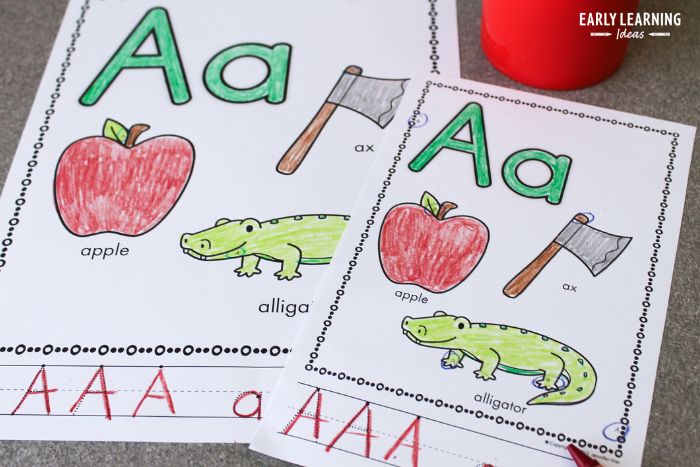
Flexible Options! These activity pages come in half sheet and full sheet sizes. There are two pages for the letter “X” (one with x as a beginning letter and one with x as an ending letter) There is one page for all other letters. Use the pages individually or bind them into an alphabet activity book. Laminate the pages to use them over and over again in a writing center.
Kids can perform the following activities on each page. Don’t forget to find the hidden letters!
- Color or finger trace large letters.
- Reinforce letter-sound awareness as they “read” and color pictures for each letter.
- Trace uppercase and lowercase letters.
- Print uppercase and lowercase letters.
- PLUS Search for 6 small letters hidden on each page
Sample These 9 Activities Today!
How’s that for a variety of alphabet activities for preschoolers?

You can purchase all 9 of the activities described above individually, or you can purchase them together in a money-saving bundle. Do you want to try them out before purchasing? Download the free sample of the letter A printables today. The ABC sampler includes all of the activities above for the letter A. To download the activity sample, click on the link below:
Free Alphabet Activity Sample
Purchase the Alphabet Activity Bundle
Click on the image below to purchase the complete alphabet bundle:
